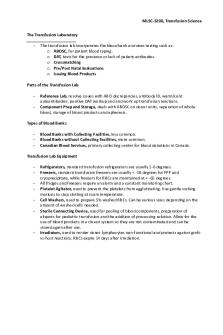K3 - intro to kinesiology PDF

| Title | K3 - intro to kinesiology |
|---|---|
| Course | Intro to Kinesiology |
| Institution | University of Wisconsin-Madison |
| Pages | 3 |
| File Size | 38.3 KB |
| File Type | |
| Total Downloads | 103 |
| Total Views | 161 |
Summary
intro to kinesiology...
Description
Most common type of lever in human body = 3rd class levers mechanical advantage = capacity to balance and overcome resistance Force arm = distance between axis and force Resistance arm = distance between axis and resistance When does the joint have a mechanical advantage? if force arm is greater than the resistance arm 2nd class levers mechanical advantage YES the force arm is always greater than resistance arm -advantage of strength 3rd class levers mechanical advantage NO the force arm is less than resistance arm advantage of speed 1st class levers mechanical advantage VARIES depends on axis advantage of speed and strength Dynamic biomechanics: osteokinematics = observable movement of bones (classified using planes/axes) Dynamic biomechanics: planes of movement -sagittal plane (right/left) -frontal/coronal plane (front/back) -transverse plane (upper/lower) Direction of the movement is determined by...? axis Axes are ________________ to the planes perpendicular
Sagittal axis = movements are in what plane? horizontally front to back movements in frontal/coronal plane Frontal/coronal axis = movements are in what plane? horizontally side to side movements are in sagittal plane longitudinal/vertical axis = movements are in what plane? vertical line - rotational movements are in transverse/horizontal plane Classification of joints -synarthroidal joint -amphiarthrosis joint -diarthrosis joint Synarthroidal joint = immoveable Amphiarthrosis joint = slightly moveable Diarthrosis joint = freely moveable Types of joints = uniaxial biaxial triaxial/multiaxial Uniaxial joint = movement in one axis (ex: elbow joint) Biaxial joint = movement in two axes (ex: wrist - flex/ext, rad/uln deviation) Triaxial/multiaxial joint = movement in all axes including all movements possible
(ex: shoulder - flex/ext, abd/add, int/ext) Types of uniaxial joints -hinge joints: allows flexion/extension -pivot joints: allows rotary movement Types of biaxial joints -condyloid/ellipsoid joints (one oval condyle fits into elliptical socket) -saddle joint (convex in one plane/concave in the other) Types of triaxial joints -ball and socket joints -gliding/plane joints -non axial joints - linear movement (ex: carpal bones joints, acromioclavicular) ***Closed packed position -maximal surface contact between the bones -attaching ligaments are under tension -capsular structures are taut -maximal joint stability ***Open/Loose packed position -joint surfaces do not fit perfectly -less stable -allow accessory movements of other joints athrokinematics = description of movement of articulating surfaces in relation to the direction of movement of extremity Fundamental movements between joint surfaces -rolling -slide -combined roll-sliding -spin Rolling motion of joints -surfaces are incongruent -new points on one surface meets new points on opposing surface -results in angular motion of bone -in normal joints, pure rolling doesn't occur but is in combo with sliding/spinning...
Similar Free PDFs

K3 - intro to kinesiology
- 3 Pages

K15 - intro to kinesiology
- 3 Pages

K14 - intro to kinesiology
- 3 Pages

K13 - intro to kinesiology
- 4 Pages

K2 - intro to kinesiology
- 3 Pages

K11 - intro to kinesiology
- 3 Pages

Intro to textiles
- 8 Pages

Intro to Med Term
- 41 Pages

Intro to Tinker CAD
- 3 Pages

Intro to Oscilloscopes
- 8 Pages

Intro to Sociology
- 34 Pages

Intro to Transfusion Science
- 3 Pages

Intro to computational physics
- 3 Pages

Intro to marketing syllabus
- 19 Pages
Popular Institutions
- Tinajero National High School - Annex
- Politeknik Caltex Riau
- Yokohama City University
- SGT University
- University of Al-Qadisiyah
- Divine Word College of Vigan
- Techniek College Rotterdam
- Universidade de Santiago
- Universiti Teknologi MARA Cawangan Johor Kampus Pasir Gudang
- Poltekkes Kemenkes Yogyakarta
- Baguio City National High School
- Colegio san marcos
- preparatoria uno
- Centro de Bachillerato Tecnológico Industrial y de Servicios No. 107
- Dalian Maritime University
- Quang Trung Secondary School
- Colegio Tecnológico en Informática
- Corporación Regional de Educación Superior
- Grupo CEDVA
- Dar Al Uloom University
- Centro de Estudios Preuniversitarios de la Universidad Nacional de Ingeniería
- 上智大学
- Aakash International School, Nuna Majara
- San Felipe Neri Catholic School
- Kang Chiao International School - New Taipei City
- Misamis Occidental National High School
- Institución Educativa Escuela Normal Juan Ladrilleros
- Kolehiyo ng Pantukan
- Batanes State College
- Instituto Continental
- Sekolah Menengah Kejuruan Kesehatan Kaltara (Tarakan)
- Colegio de La Inmaculada Concepcion - Cebu

